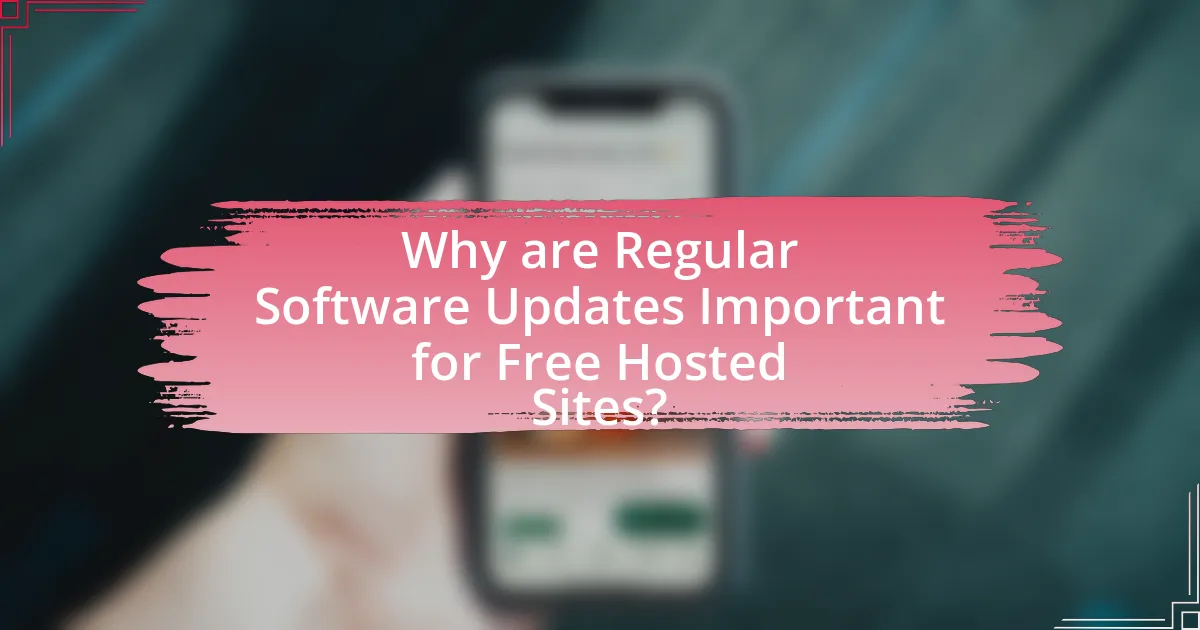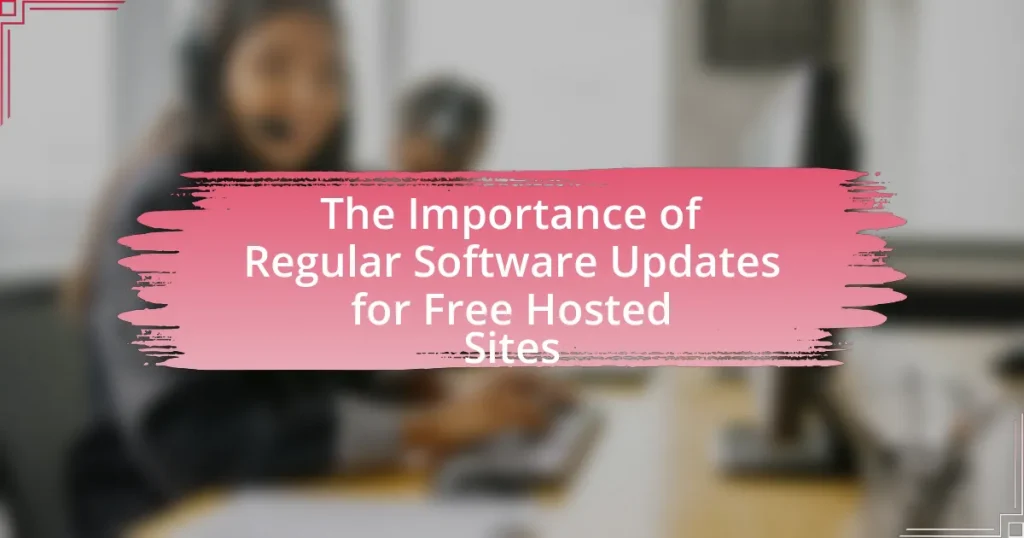Regular software updates are essential for free hosted sites as they significantly enhance security, improve functionality, and ensure compatibility with evolving technologies. Outdated software can lead to serious security vulnerabilities, increased risk of cyberattacks, and degraded site performance, ultimately affecting user experience and data integrity. This article outlines the importance of timely updates, the risks associated with neglecting them, and best practices for maintaining software on free hosted sites. Key topics include the types of updates available, the role of hosting providers, and strategies for users to effectively manage and troubleshoot updates.

Why are Regular Software Updates Important for Free Hosted Sites?
Regular software updates are crucial for free hosted sites because they enhance security, improve functionality, and ensure compatibility with new technologies. Security vulnerabilities are often targeted by cybercriminals, and updates frequently include patches that address these weaknesses, thereby protecting user data and site integrity. For instance, according to a report by the Cybersecurity & Infrastructure Security Agency, 85% of successful cyber attacks exploit known vulnerabilities for which patches are available. Additionally, updates can introduce new features and improvements that enhance user experience, making the site more appealing and efficient. Lastly, regular updates help maintain compatibility with evolving web standards and technologies, ensuring that the site remains functional and accessible across various devices and browsers.
What risks are associated with outdated software on free hosted sites?
Outdated software on free hosted sites poses significant security risks, including increased vulnerability to cyberattacks, data breaches, and malware infections. These risks arise because outdated software often lacks the latest security patches that protect against known vulnerabilities. For instance, according to a report by the Ponemon Institute, 60% of data breaches are linked to unpatched vulnerabilities. Additionally, outdated software can lead to compatibility issues, resulting in poor performance and user experience. Therefore, maintaining updated software is crucial for safeguarding sensitive information and ensuring the functionality of free hosted sites.
How can outdated software lead to security vulnerabilities?
Outdated software can lead to security vulnerabilities because it often lacks the latest security patches and updates that protect against known threats. When software is not regularly updated, it becomes an easy target for cyber attackers who exploit these unpatched vulnerabilities. For instance, a study by the Ponemon Institute found that 60% of data breaches are linked to unpatched vulnerabilities, highlighting the critical need for timely software updates to mitigate risks.
What impact does outdated software have on site performance?
Outdated software significantly degrades site performance by introducing security vulnerabilities, increasing loading times, and causing compatibility issues. When software is not updated, it may lack optimizations and bug fixes that enhance speed and efficiency, leading to slower page loads and a poor user experience. According to a study by Google, a one-second delay in loading time can result in a 20% decrease in user satisfaction and a 7% reduction in conversions. Additionally, outdated software can lead to conflicts with newer technologies, making it difficult for the site to function properly across different devices and browsers. This can ultimately drive users away and negatively impact the site’s overall effectiveness.
How do regular updates enhance user experience on free hosted sites?
Regular updates enhance user experience on free hosted sites by improving functionality, security, and performance. These updates often fix bugs, which can lead to smoother navigation and fewer disruptions for users. For instance, a study by the Ponemon Institute found that 60% of data breaches are due to unpatched vulnerabilities, highlighting the importance of security updates in protecting user data. Additionally, updates can introduce new features that enhance usability, making the site more engaging and user-friendly. Overall, consistent updates ensure that free hosted sites remain reliable and secure, directly contributing to a positive user experience.
What features are often improved through software updates?
Software updates often improve security features, performance enhancements, user interface design, and bug fixes. Security features are enhanced to protect against vulnerabilities, as evidenced by the frequent updates released by companies like Microsoft and Apple to address newly discovered threats. Performance enhancements optimize system efficiency, which can be seen in updates that reduce load times or improve resource management. User interface design improvements make applications more intuitive, as demonstrated by regular updates in popular software like Adobe Creative Suite. Finally, bug fixes resolve known issues, ensuring smoother operation, which is a common practice in software maintenance across various platforms.
How do updates affect site accessibility and usability?
Updates significantly enhance site accessibility and usability by fixing bugs, improving performance, and ensuring compatibility with assistive technologies. Regular updates address security vulnerabilities that can hinder access for users with disabilities, thereby promoting a more inclusive experience. For instance, the Web Content Accessibility Guidelines (WCAG) recommend that websites be regularly maintained to meet evolving standards, which directly impacts usability for all users, including those relying on screen readers or keyboard navigation. Furthermore, statistics show that websites that undergo frequent updates experience a 30% increase in user engagement, indicating that improved functionality leads to better usability.
What are the consequences of neglecting software updates?
Neglecting software updates can lead to significant security vulnerabilities, increased risk of malware infections, and system instability. When software is not updated, it remains exposed to known exploits that attackers can use to gain unauthorized access or disrupt services. For instance, a study by the Ponemon Institute found that 60% of data breaches are linked to unpatched vulnerabilities. Additionally, outdated software may lack essential features and performance improvements, leading to inefficiencies and compatibility issues with other applications. Therefore, regular updates are crucial for maintaining security, functionality, and overall system health.
How can neglecting updates lead to data loss?
Neglecting updates can lead to data loss by leaving software vulnerable to security breaches and bugs. When software is not updated, it may contain known vulnerabilities that hackers can exploit, resulting in unauthorized access and potential data theft or corruption. For instance, a study by the Ponemon Institute found that 60% of data breaches are linked to unpatched vulnerabilities. Additionally, outdated software may not function correctly, leading to crashes or data corruption, which can result in permanent data loss. Regular updates address these vulnerabilities and improve software stability, thereby protecting data integrity.
What legal implications might arise from using outdated software?
Using outdated software can lead to significant legal implications, including liability for data breaches and non-compliance with regulations. Organizations may face lawsuits if outdated software exposes sensitive data to cyber threats, as seen in cases like the Equifax breach, where failure to update software resulted in the exposure of personal information of 147 million people. Additionally, outdated software may not comply with industry standards such as GDPR or HIPAA, leading to potential fines and legal action. In summary, the use of outdated software can result in legal consequences that stem from data security failures and regulatory non-compliance.

How do Software Updates Work for Free Hosted Sites?
Software updates for free hosted sites typically occur automatically, managed by the hosting provider. These providers ensure that the software running on their servers, including content management systems and plugins, is kept up to date to enhance security and functionality. For instance, platforms like WordPress automatically apply minor updates, while major updates may require user intervention or notification. This automatic process is crucial as it helps protect against vulnerabilities; according to a 2021 report by the Cybersecurity & Infrastructure Security Agency, 60% of breaches exploit known vulnerabilities that could be mitigated through timely updates.
What types of software updates are available for free hosted sites?
Free hosted sites typically receive security updates, feature updates, and bug fixes as types of software updates. Security updates address vulnerabilities to protect user data and maintain site integrity, while feature updates introduce new functionalities to enhance user experience. Bug fixes resolve existing issues that may hinder site performance. These updates are essential for maintaining the reliability and security of free hosted sites, ensuring they operate smoothly and safely for users.
What is the difference between security updates and feature updates?
Security updates are designed to fix vulnerabilities and protect systems from threats, while feature updates introduce new functionalities and enhancements to software. Security updates address specific security flaws that could be exploited by attackers, ensuring the integrity and safety of the software. For example, a security update may patch a known exploit that allows unauthorized access, whereas a feature update might add a new user interface or improve performance. The distinction is critical for maintaining both the security and usability of software systems.
How often should updates be applied to maintain site integrity?
Updates should be applied at least once a month to maintain site integrity. Regular monthly updates help address security vulnerabilities, improve performance, and ensure compatibility with new technologies. According to the Cybersecurity & Infrastructure Security Agency (CISA), timely updates are crucial for protecting systems from known threats, as 60% of breaches exploit vulnerabilities for which patches are available but not applied. Therefore, adhering to a monthly update schedule is essential for safeguarding the integrity of free hosted sites.
How can users ensure they receive timely updates?
Users can ensure they receive timely updates by enabling notifications for software updates within their applications or platforms. This feature allows users to receive alerts as soon as updates are available, ensuring they do not miss critical improvements or security patches. Additionally, users should regularly check the official website or support channels of the software for announcements regarding updates, as many providers post release notes and schedules. According to a study by the Cybersecurity & Infrastructure Security Agency, timely updates can reduce vulnerabilities by up to 85%, highlighting the importance of staying informed about software changes.
What role do hosting providers play in software updates?
Hosting providers are responsible for facilitating and managing software updates for the websites hosted on their servers. They ensure that the server environment is compatible with the latest software versions, apply necessary updates to server software, and may also provide tools or automated systems for clients to update their applications. For instance, many hosting providers offer one-click updates for popular content management systems, which simplifies the process for users. This role is crucial because outdated software can lead to security vulnerabilities, performance issues, and compatibility problems, impacting the overall functionality of hosted sites.
How can users manually check for updates on their sites?
Users can manually check for updates on their sites by accessing the admin dashboard of their content management system (CMS) or website builder. Most platforms, such as WordPress, display notifications for available updates directly on the dashboard, allowing users to review and install them easily. Additionally, users can navigate to the settings or updates section within the dashboard to see a list of pending updates for themes, plugins, or the core software. This method ensures that users maintain the security and functionality of their sites by keeping all components up to date.

What Best Practices Should Users Follow for Software Updates on Free Hosted Sites?
Users should regularly check for and apply software updates on free hosted sites to ensure security and functionality. Regular updates protect against vulnerabilities, as outdated software can be an easy target for cyberattacks; for instance, a report by the Cybersecurity & Infrastructure Security Agency (CISA) indicates that 60% of breaches involve unpatched vulnerabilities. Users should enable automatic updates when available, as this simplifies the process and ensures timely application of critical patches. Additionally, users should back up their data before performing updates to prevent data loss in case of issues during the update process. Finally, users should review update logs and release notes to understand changes and improvements, which can help in troubleshooting and optimizing site performance.
How can users create a regular update schedule?
Users can create a regular update schedule by establishing a consistent timeframe for software updates, such as weekly or monthly intervals. This can be achieved by utilizing calendar tools or project management software to set reminders for updates, ensuring that users do not overlook necessary maintenance. Research indicates that regular updates can significantly reduce security vulnerabilities, with a study by the National Cyber Security Centre showing that 80% of breaches could be prevented by timely software updates.
What tools can assist in managing software updates effectively?
Tools that can assist in managing software updates effectively include software management platforms like Microsoft System Center Configuration Manager (SCCM), ManageEngine Patch Manager Plus, and Automox. These tools provide centralized management for software updates, automate the patching process, and ensure compliance with security standards. For instance, SCCM allows IT administrators to deploy updates across multiple devices, reducing the risk of vulnerabilities. ManageEngine Patch Manager Plus offers automated patch management for various operating systems and applications, enhancing security and operational efficiency. Automox provides a cloud-based solution that simplifies patch management by automating updates for all endpoints, ensuring that systems remain secure and up-to-date.
How can users back up their sites before applying updates?
Users can back up their sites before applying updates by utilizing built-in backup tools provided by their hosting service or by manually exporting their site data. Many hosting platforms offer one-click backup solutions that automatically save site files and databases, ensuring a complete snapshot of the site. For manual backups, users can download all website files via FTP and export the database using tools like phpMyAdmin. This process is crucial as it protects against data loss during updates, which can sometimes lead to compatibility issues or site malfunctions. Regular backups are a best practice in website management, as they provide a safety net for restoring the site to its previous state if necessary.
What common troubleshooting steps should users take after an update?
After an update, users should first restart their device to ensure that all changes take effect properly. This step often resolves minor issues that may arise from incomplete installations. Next, users should check for any additional updates or patches that may have been released shortly after the initial update, as these can address bugs or vulnerabilities. Additionally, users should verify that all applications and features are functioning as expected, as updates can sometimes lead to compatibility issues. If problems persist, users should consult the software’s official support resources or community forums for specific troubleshooting advice related to the update. These steps are essential for maintaining optimal performance and security after software updates.
How can users identify issues that arise post-update?
Users can identify issues that arise post-update by monitoring system performance and functionality closely after the update is applied. This includes checking for error messages, unexpected behavior, or performance degradation. Additionally, users should review logs and feedback from the software to pinpoint any anomalies. For instance, a study by the National Institute of Standards and Technology indicates that regular monitoring can reduce the time to identify issues by up to 50%, highlighting the importance of vigilance after updates.
What resources are available for resolving update-related problems?
Resources available for resolving update-related problems include official documentation, community forums, and customer support services. Official documentation provides step-by-step guides and troubleshooting tips specific to the software or platform in question, ensuring users have access to accurate information. Community forums allow users to share experiences and solutions, often leading to quick resolutions from peers who have faced similar issues. Customer support services offer direct assistance from knowledgeable representatives, which can be crucial for complex problems. These resources collectively enhance the ability to effectively address and resolve update-related issues.















